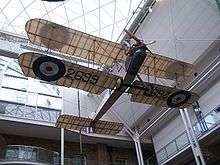Aircraft dope

Aircraft dope is a plasticised lacquer that is applied to fabric-covered aircraft. It tightens and stiffens fabric stretched over airframes, which renders them airtight and weatherproof.[1]
Typical doping agents include nitrocellulose, cellulose acetate and cellulose acetate butyrate. Liquid dopes are highly flammable; nitrocellulose, for instance, is also known as the explosive propellant "guncotton". Dopes often include colouring pigments to facilitate even application, and are available in a wide range of colors.
Dope has been applied to various aircraft fabrics, including madapolam,[2] but also more recently on polyester and other fabrics with similar fine weave and absorbent qualities.[3]
Accidents
Accidents have occurred when dope is not used correctly, for example when mixed with other chemicals, used on the wrong fabrics, or applied to contaminated or improperly prepared surfaces.
On 27 April 1995 91-year-old aircraft designer and builder Steve Wittman and his wife were killed when their Wittman O&O Special broke up in flight due to delamination and separation of the wing fabric, resulting in wing aeroelastic flutter. The US National Transportation Safety Board stated in their investigation report: "A small section of the wing wood and fabric material was removed for examination. The examination disclosed that the mahogany plywood had been coated with clear Nitrate Dope. Next, the builder covered the plywood with Stits 150 pound poly-fiber. The builder next brushed a coat of nitrate dope over the layer of poly-fiber followed by a clear coat of butyrate dope. Finally, several coats of poly-spray and yellow poly-tone were sprayed over the coat butyrate dope. According to Mr. Ray Stits, President of Stits Aircraft, the above stated process does not provide the best adhesive qualities. The builder should have first applied two coats of poly-brush on the bare plywood, (see the Poly-Fiber Covering and Painting Manual)."[4]
References
- ↑ Crane, Dale: Dictionary of Aeronautical Terms, third edition, page 170. Aviation Supplies & Academics, 1997. ISBN 1-56027-287-2
- ↑ Hickman, Kennedy (2012). "World War II: De Havilland Mosquito". About.com. Retrieved 6 January 2012.
- ↑ Wills, Philip (1966). British Gliding Association Handbook.
- ↑ National Transportation Safety Board (December 1995). "Brief of Accident" (PDF). Archived from the original (PDF) on March 22, 2012. Retrieved 27 August 2011.